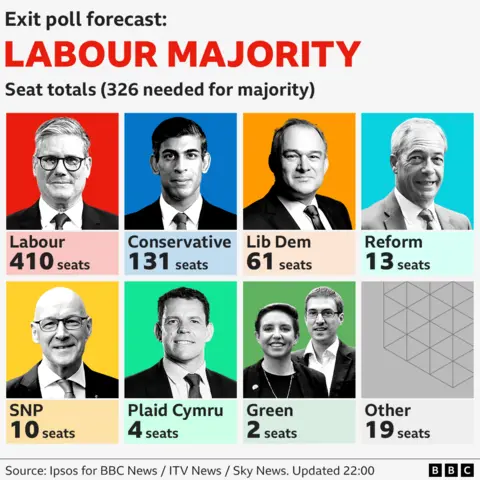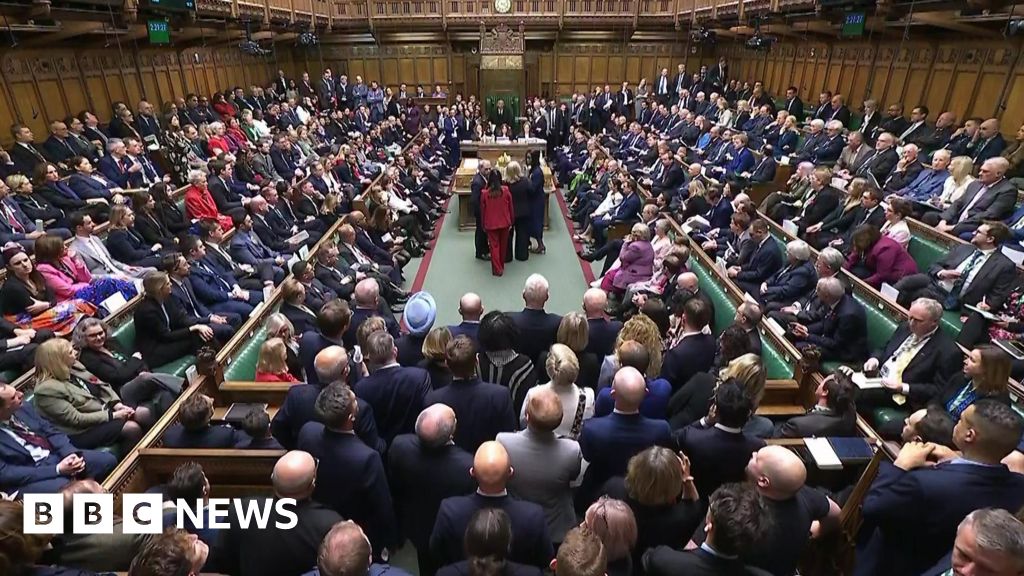ARTICLE AD BOX

 BBC
BBC
The Labour Party is forecast to win a landslide majority in Parliament, according to an exit poll published as voting ended in the 2024 general election.
Labour is set to take 410 seats, well ahead of the Conservatives on 131, according to the forecast based on the poll carried out by Ipsos for the BBC, ITV News and Sky News.
This suggests Labour is on course for a majority of 170 seats, although they may have fallen just short of the majority Tony Blair won in 1997.
The Liberal Democrats are currently forecast to win 61 seats, Reform UK 13, the SNP 10, Plaid Cymru is on four and the Green Party two.
Other parties, including those in Northern Ireland, are forecast to get 19 seats.
Enter your postcode or a constituency name to find what the exit poll forecast is currently suggesting may happen in your area.
Bear in mind that this is only an indication of what may happen. Sir John Curtice, who leads the exit poll team, says the number of seats Reform will win is particularly uncertain.
He explains: “Our model suggests there are many places where they have some, but a relatively low, chance of winning.”
This look-up will be updated as results come in and the forecasts are modified.
What is the exit poll
The exit poll is a way of forecasting what may happen in the general election, after voting ends but before the results are known.
The poll focuses on revealing national trends and is mainly used to forecast which party may form the government at Westminster.
Forecasting results at a constituency level is harder, especially if there are local factors that make the election distinct in any particular seat.
Researchers at 133 polling stations across England, Scotland and Wales ask around 20,000 people to indicate which way they voted.
A team of academics led by Sir John Curtice, professor of politics at Strathclyde University, uses this and other data to estimate the vote share per party in each constituency and then to forecast each party's likelihood of winning in any given seat.
All the individual probabilities are added together to arrive at the forecast seat totals for each party. The exit poll is not held in Northern Ireland so the 18 seats there are labelled “Other”.
The model is updated throughout the night as results come in, so seat totals and individual constituencies are likely to change.
Pattern across Great Britain
These maps show the exit poll forecast across England, Wales and Scotland.
In the locations coloured grey, the contest is very close. Everywhere else is coloured by the party currently considered most likely to win.
When an actual result is declared it will overwrite the exit poll data in this map, and in the postcode lookup above.
Again, the forecasts may change over the night. You will need to refresh this page to see those updates.
Rural constituencies are larger than those in cities because the population is more spread out.
So here is the same data in a cartogram, where each constituency is shown as equal in size.
The cartogram is a way of viewing each seat as the same size, while attempting to show roughly where in the UK they are.
All the seats are correctly within the right nation and English region, but they may not follow typical geography beyond that.
There are some, mostly around London - whose high population density distorts the map most significantly - that are in different places to where you'd expect, no longer neighbouring the seats they lie next to geographically.
Note
Credits
Look-up developed and designed by Scott Jarvis and Prina Shah, produced by Christine Jeavans. Cartogram template used with thanks to Philip Brown and Alasdair Rae.

 11 months ago
36
11 months ago
36








 English (US) ·
English (US) ·